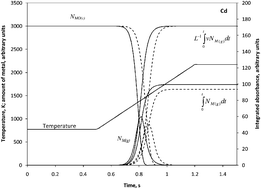A method is suggested for simulation of transient sample vapor composition and release rate during vaporization of analytes in electrothermal (ET) atomizers for AAS. The approach is based on the Langmuir theory of evaporation of metals in the presence of a gas at atmospheric pressure, which advocates formation of mass equilibrium in the boundary layer next to the evaporation surface. It is suggested in this work that in ET atomizers the release of atoms and molecules from the boundary layer next to the dry residue of the analyte is accompanied by spreading of the layer around the sample droplets or crystals. Thus, eventually, the vapor source forms an effective area associated with a monolayer of the analyte. In particular, for the case of a metal oxide analyte as discussed in the work, the boundary layer contains the species present in thermodynamic equilibrium with oxide, which are metal atoms and dimers, oxide molecules and oxygen. Because of an excess of Ar, the probability of mass and energy exchange between the evolved gaseous species is low, this substantiates independent mass transport of each type of species from the boundary layer and through absorption volume. Diffusion, capture by Ar flow and gas thermal expansion is considered to control vapor transport and release rate. Each specific flow is affected by secondary processes occurring in collisions of the evolved molecules and atoms with the walls of graphite tube. Diffusion of oxygen containing species out of the boundary layer is facilitated by annihilation of oxygen and reduction of oxide on the graphite surface, while interaction of metal vapor with graphite slows down transport of atomic vapor out of the atomizer. These assumptions are used as the basis for the presentation of the problem as a system of first order differential equations describing mass and temperature balance in the atomizer. Numerical solution of the system of equations provides the simulation of temporal composition of the sample constituents in condensed and gas phase in the atomizer according to chemical properties of the analyte and experimental conditions. The suggested approach avoids the description of atomization processes via kinetic parameters such as activation energy, frequency factor, surface coverage or reaction order.

You have access to this article
 Please wait while we load your content...
Something went wrong. Try again?
Please wait while we load your content...
Something went wrong. Try again?


 Please wait while we load your content...
Please wait while we load your content...